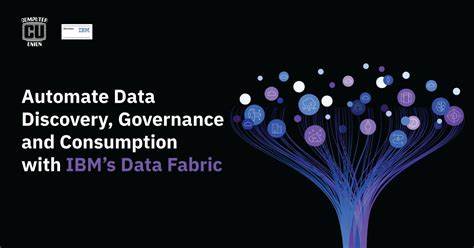Data fabric architecture delivers instant benefits
What is a data fabric?
In the past, organizations have attempted to address data access
problems either through point-to-point integration or introduction of
data hubs. Neither of those are suitable when data is highly distributed
and siloed. Point-to-point integrations add exponential cost for any
additional end point that needs to be connected, meaning this is
a non-scalable approach. Data hubs allow for easier integration
of applications and sources but exacerbate the cost and complexity
to maintain quality and trust of data within the hub.
The data fabric is an emerging architecture that aims to address the
data challenges arising out of a hybrid data landscape. Its fundamental
idea is to strike a balance between decentralization and globalization
by acting as the virtual connective tissue between data endpoints.
Through technologies such as automation and augmentation of
integration, federated governance as well as activation of metadata,
a data fabric architecture enables dynamic and intelligent data
orchestration across a distributed landscape, creating a network
of instantly available information to power a business.
A data fabric is agnostic to deployment platforms, data processes,
geographical locations and architectural approach. It facilitates the
use of data as an enterprise asset. A data fabric ensures your various
kinds of data can be successfully combined, accessed, and governed
both efficiently and effectively.

Business benefits of a data fabric
Data only delivers business value when it is contextualized and
becomes accessible by any user or application in the organization.
When implemented correctly, a data fabric helps ensure those values
are available throughout the organization in the most efficient and
automated way possible. As such, the fabric has three key benefits:
1. Enable self-service data consumption and collaboration.
2. Automate governance, protection and security; enabled
by active metadata.
3. Automate data engineering tasks and augment data
integration across hybrid cloud resources.
Enable self-service data consumption and collaboration
By integrating data from multiple sources and analyzing a larger
fraction of the enormous amount of data generated daily, organizations
gain better insights and respond more quickly to changing business
demands.
A data fabric rapidly delivers data into the hands of those
who need it. Self-service enables the organization as a whole to find
appropriate data quicker and spend more time using that data to
provide tangible insights.
Benefits of data fabric for self-service data consumption:
– Business users have a single point of access to find, understand,
shape and consume data throughout the organization.
– A centralized data governance and lineage help users understand
what the data means, where it comes from, and how it is related
to other assets.
– Extensive and customizable metadata management scales
easily and is accessible via APIs.
– Self-service access to trusted and governed data enables
line-of-business collaboration with other users.
A Forrester Total Economic Impact study1 revealed that these
capabilities can mean
How IBM delivers a data fabric
IBM Cloud Pak® for Data makes this concept of a data fabric possible. IBM Cloud Pak for Data is an insight platform that simplifies and automates data collection, organization and analysis of data and accelerates the infusion of AI throughout your business. With its capabilities to connect data everywhere; run workloads anywhere; and to build, deploy and manage AI at scale in hybrid cloud environments, IBM Cloud Pak for Data is the enabler for a business digital transformation.
Data fabric in action
The best way to understand the value of a data fabric is to see the business benefits that actual organizations have achieved through implementing a data fabric on top of an insight platform. Energy company The challenges section at the beginning of this white paper introduced the case of a North American energy company undergoing a digital transformation. This customer engaged with IBM who implemented a data fabric architecture based on IBM Cloud Pak for Data. With a flexible and integrated data fabric in place, the company was able to implement a range of important data projects across different units, including: – eMobility – Gas operations document discovery, including handwriting extraction – Electric customer segmentation and load forecasting – Asset management – COVID-19 load impacts – Return-to-work risk model With a data fabric, this organization is able to: – Provide multiple business units with direct data access via a self-service insight platform. – Use fit-for-purpose compute capacity to efficiently run models on billions of rows of data. – Collaboratively develop models and easily deploy those models to infuse insight throughout the company

Data fabric is the transformative next step for your enterprise
With a data fabric built on IBM Cloud Pak for Data technology, you can hyper-automate data discovery, data governance, and data consumption in a hybrid and multicloud data landscape. Employ a data fabric to enable faster time-to-value for business users, higher productivity for data engineering and operations, and greater governance and compliance fidelity.
